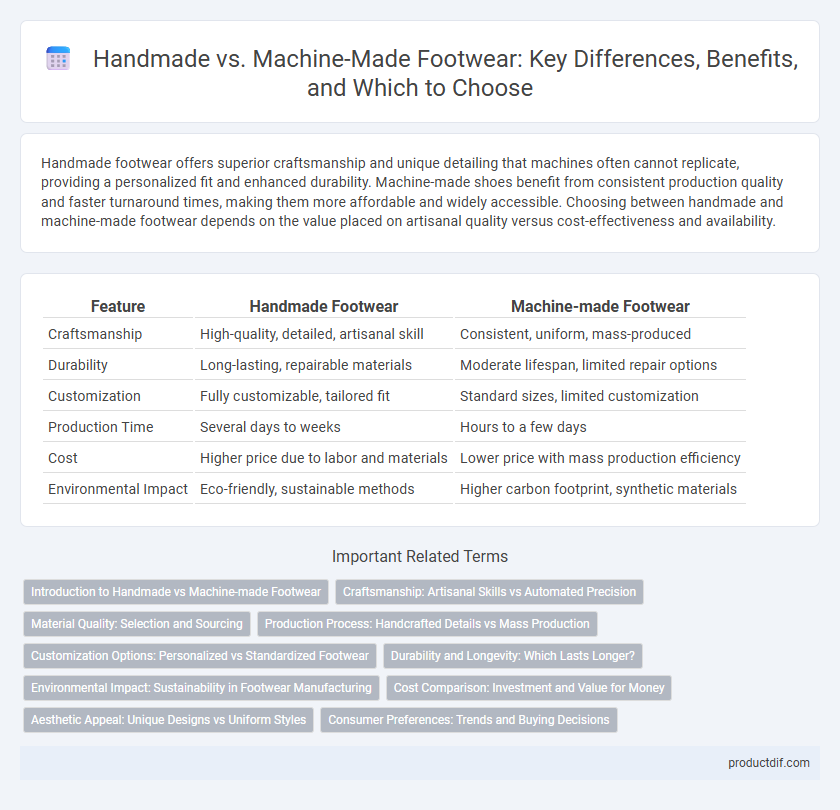Handmade footwear offers superior craftsmanship and unique detailing that machines often cannot replicate, providing a personalized fit and enhanced durability. Machine-made shoes benefit from consistent production quality and faster turnaround times, making them more affordable and widely accessible. Choosing between handmade and machine-made footwear depends on the value placed on artisanal quality versus cost-effectiveness and availability.
Table of Comparison
| Feature | Handmade Footwear | Machine-made Footwear |
|---|---|---|
| Craftsmanship | High-quality, detailed, artisanal skill | Consistent, uniform, mass-produced |
| Durability | Long-lasting, repairable materials | Moderate lifespan, limited repair options |
| Customization | Fully customizable, tailored fit | Standard sizes, limited customization |
| Production Time | Several days to weeks | Hours to a few days |
| Cost | Higher price due to labor and materials | Lower price with mass production efficiency |
| Environmental Impact | Eco-friendly, sustainable methods | Higher carbon footprint, synthetic materials |
Introduction to Handmade vs Machine-made Footwear
Handmade footwear involves skilled artisans meticulously crafting each pair, ensuring superior quality, unique design, and personalized fit, often resulting in higher durability and comfort. Machine-made footwear utilizes automated manufacturing processes to produce shoes at scale, offering affordability and consistency but sometimes sacrificing customization and craftsmanship. Understanding these differences helps consumers choose between artisanal excellence and mass-produced convenience in footwear.
Craftsmanship: Artisanal Skills vs Automated Precision
Handmade footwear showcases artisanal skills through meticulous attention to detail and unique craftsmanship, resulting in personalized, high-quality shoes. Machine-made shoes benefit from automated precision, allowing for consistent sizing, faster production, and scalability in manufacturing. The choice between handmade and machine-made footwear ultimately depends on the desired balance between bespoke artistry and mass-market efficiency.
Material Quality: Selection and Sourcing
Handmade footwear often utilizes premium, carefully selected leathers and natural materials sourced from artisanal tanneries committed to sustainable practices, ensuring superior breathability and durability. Machine-made shoes typically use mass-produced synthetic fabrics and lower-grade leathers, prioritizing cost efficiency over material excellence. The meticulous material sourcing in handmade production contributes significantly to enhanced comfort, longevity, and overall quality in the final product.
Production Process: Handcrafted Details vs Mass Production
Handmade footwear features intricate handcrafted details achieved through skilled artisans carefully shaping, stitching, and finishing each pair, ensuring unique quality and durability. In contrast, machine-made shoes rely on automated processes designed for mass production, emphasizing speed and volume but often compromising on personalized craftsmanship and precision. The production process in handmade shoes prioritizes meticulous attention to detail, resulting in superior comfort and bespoke fits, unlike uniformity found in factory-produced footwear.
Customization Options: Personalized vs Standardized Footwear
Handmade footwear offers extensive customization options, allowing for personalized measurements, unique materials, and tailored designs that reflect individual style and comfort preferences. Machine-made footwear typically follows standardized patterns and mass production techniques, limiting customization to preset sizes and styles. This difference makes handmade shoes ideal for customers seeking one-of-a-kind, perfectly fitted footwear, while machine-made options cater to fast, uniform production and affordability.
Durability and Longevity: Which Lasts Longer?
Handmade footwear often boasts superior durability due to meticulous craftsmanship and high-quality materials that are carefully selected and assembled, ensuring enhanced longevity. Machine-made shoes provide consistency and affordability but may lack the tailored reinforcement found in handmade pairs, often resulting in shorter lifespan under heavy use. Choosing handmade footwear generally guarantees a longer-lasting product that better withstands wear and tear over time.
Environmental Impact: Sustainability in Footwear Manufacturing
Handmade footwear typically results in lower carbon emissions due to minimal reliance on energy-intensive machinery, promoting sustainable production practices. Machine-made shoes often involve mass production techniques that contribute to higher energy consumption and increased waste generation. Sustainable footwear manufacturing prioritizes eco-friendly materials and processes, favoring handcrafted methods to reduce environmental impact.
Cost Comparison: Investment and Value for Money
Handmade footwear typically demands higher initial investment due to skilled labor and premium materials but offers superior durability and customization, enhancing long-term value for money. Machine-made shoes benefit from cost-efficient mass production, resulting in lower upfront prices but often compromise on individual fit and craftsmanship quality. Evaluating cost versus longevity and comfort, handmade footwear generally provides better value despite higher initial costs.
Aesthetic Appeal: Unique Designs vs Uniform Styles
Handmade footwear showcases unique designs with intricate details reflecting artisanal craftsmanship, creating one-of-a-kind aesthetic appeal. Machine-made shoes offer uniform styles with consistent patterns, catering to mass-market demand for reliable design standards. The choice between handmade and machine-made footwear significantly impacts the distinctiveness and visual character of the shoe collection.
Consumer Preferences: Trends and Buying Decisions
Consumer preferences in footwear increasingly favor handmade shoes for their unique craftsmanship, durability, and premium materials, appealing to buyers valuing authenticity and exclusivity. Machine-made footwear dominates due to affordability, mass production, and consistent quality, attracting cost-conscious consumers and those seeking trendy designs. Recent market trends show a growing niche for sustainable handmade options, influencing buying decisions toward ethically-produced, artisanal footwear.
Handmade vs Machine-made Infographic

 productdif.com
productdif.com